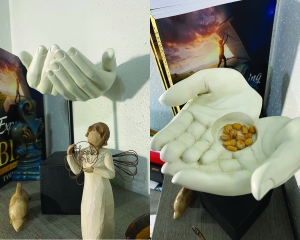‘Tis truth divine, exhibited on earth,
Gives charity her being.
Cowper
Isabella, the wife of Dr. John Graham, was born in Scotland, on the twenty-ninth of July, 1742. At the age of seventeen she became a member of the church in Paisley of which the Rev. Dr. Witherspoon, afterwards President of Princeton college, was the pastor. Dr. Graham was a physician of the same town. Her marriage took place in 1765. The next year Dr. Graham was ordered to join his regiment then stationed in Canada. After spending a few months at Montreal, he removed to Fort Niagara, where he remained in the garrison four years.
Just before the Revolutionary war the sixteenth regiment of Royal Americans was ordered to the island of Antigua. Thither Dr. Graham removed with his family, and there he died in 1774. Mrs. Graham then returned to her native land.
In 1789 she came to this country, and permanently settled in the city of New York. She there opened a school for young ladies, and gained a high reputation in her profession. She united with the Presbyterian church of which John Mason, D. D., was pastor, and was noted, through all the latter years of her life, for the depth of her piety and her Christian benevolence. She made it a rule to give a tenth part of her earnings to religious and charitable purposes. In 1795 she received, at one time, an advance of a thousand pounds on the sale of a lease which she held on some building lots: and not being used to such large profits, she said, on receiving the money, “Quick, quick, let me appropriate the tenth before my heart grows hard.”
Two years afterwards, a society was organized and chartered, for the relief of poor widows; and Mrs. Graham was appointed first directress. Each of the managers had a separate district, and she had the superintendence of the whole. A house was purchased by the society, where work was received for the employment of the widows; and a school was opened for the instruction of their children. “Besides establishing this school, Mrs. Graham selected some of the widows, best qualified for the task, and engaged them, for a small compensation, to open day schools for the instruction of the children of widows, in distant parts of the city: she also established two Sabbath schools, one of which she superintended herself, and the other she placed under the care of her daughter. Wherever she met with Christians sick and in poverty, she visited and comforted them; and in some instances opened small subscription lists to provide for their support. She attended occasionally for some years at the Alms House for the instruction of the children there, in religious knowledge: in this work she was much assisted by a humble and pious female friend, who was seldom absent from it on the Lord’s day.
“It was often her custom to leave home after breakfast, to take with her a few rolls of bread, and return in the evening about eight o’clock. Her only dinner on such days was her bread, and perhaps some soup at the Soup House, established by the Humane Society for the poor, over which one of her widows had been, at her recommendation, appointed.” *
In the winter of 1804-5, before a Tract or Bible Society had been formed in New York, she visited between two and three hundred of the poorer families, and supplied them with a Bible where they were destitute. She also distributed tracts which were written, at her request, by a friend, “and lest it might be said it was cheap to give advice, she usually gave a small sum of money along with the tracts.”
On the fifteenth of March, 1806, a society was organized in New York for providing an Asylum for Orphan Children; and Mrs. Graham occupied the chair on the occasion. Her sympathies were strongly enlisted in this organization, and she was one of the trustees at the time of her death.
“In the winter of 1807-8, when the suspension of commerce by the embargo, rendered the situation of the poor more destitute than ever, Mis Graham adopted a plan best calculated in her view to detect the idle applicant for charity, and at the same time to furnish employment for the more worthy amongst the female poor. She purchased flax, and lent wheels where applicants had none. Such as were industrious took the work with thankful-ness, and were paid for it; those who were beggars by profession, never kept their word to return for the flax or the wheel. The flax thus spun was afterwards woven, bleached, and made into table-cloths and towels for family use.”*
When the Magdalen Society was established by some gentlemen, in 1811, a board of ladies was elected for the purpose of superintending the internal management of the house; and Mrs. Graham was chosen President. This office she continued to hold till her death. The next year the trustees of the Lancasterian School solicited the services of several women to instruct the pupils in the catechism. Mrs. Graham cheerfully assisted in this task, instruction being given one afternoon in each week.
“In the spring of 1814 she was requested to unite with some ladies, in forming a Society for the Promotion of Industry amongst the poor. The Corporation of the city having returned a favorable answer to their petition for assistance, and provided a house, a meeting of the Society was held, and Mrs. Graham once more was called to the chair. It was the last time she was to preside at the formation of a new society. Her articulation, once strong and clear, was now observed to have become more feeble. The ladies present listened to her with affectionate attention; her voice broke upon the ear as a pleasant sound that was passing away. She consented to have her name inserted in the list of managers, to give what assistance her age would permit in forwarding so beneficent a work. Although it pleased God to make her cease from her labors, before the House of Industry was opened, yet the work was carried on by others, and prospered. Between four and five hundred women were employed and paid during the following winter. The Corporation declared in strong terms their approbation of the result, and enlarged their donation, with a view to promote the same undertaking for the succeeding winter.”
Mrs. Graham died on the twenty-seventh of July, 1814. Of no woman of the age may it be said with more propriety, as it was of Dorcas: “This woman was full of good works and alms-deeds, which she did.” Yet few women are more humble than was Mrs. Graham, or think less of their benevolent deeds. Her daughter, Mrs. Bethune, writing of her decease, says that she departed in peace, not trusting in her wisdom or virtue, like the philosophers of Greece and Rome; not even, like Addison, calling on the profligate to see a good man die; but, like Howard, afraid that her good works might have a wrong place in the estimate of her hope, her chief glory was that of a “sinner saved by grace.”
• Mrs Bethune’s Life of Mrs. Graham, abridged,
• Mrs. Bethune
______
Excerpted from Noble Deeds of American Women
(Patriotic Series for Boys and Girls)
Edited by J. Clement
——
With an Introduction by Mrs. L. H. Sigourney
Illustrated
BOSTON: Lee and Shepard, Publishers
Entered by Act of Congress, in the year of 1851,
by E. H. Derby and Co., in the Clerk’s Office of the Northern District of New York
______


